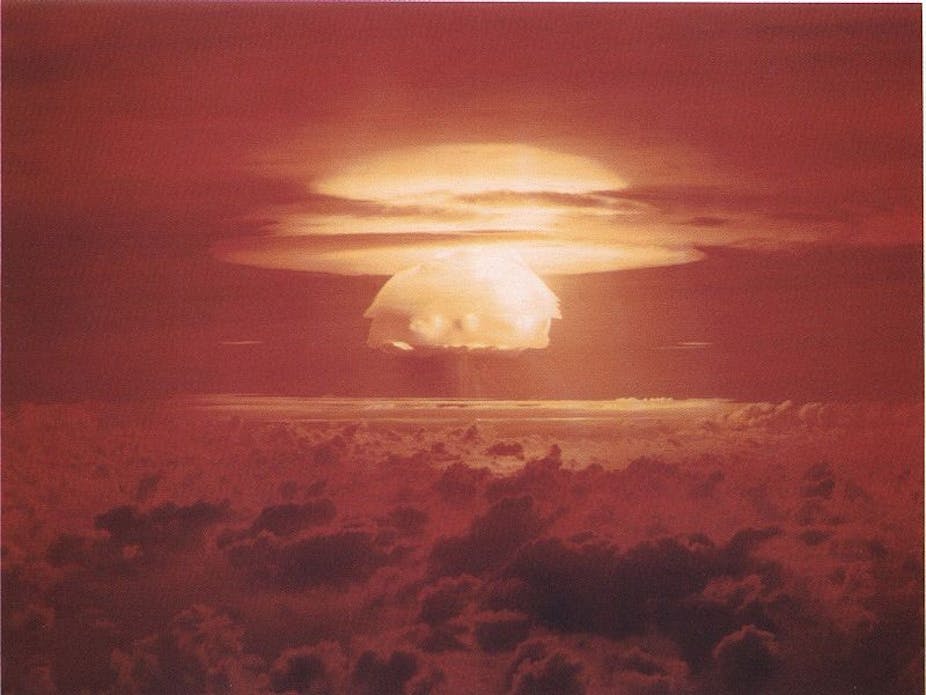It was a key moment in the Cold War: 50 years ago, on August 5, 1963, US and the Soviet Union signed the Limited Test Ban Treaty banning nuclear tests in the atmosphere, underwater and in outer space (but not underground). The treaty has since been signed, if not ratified, by most countries around the world and remains in force to this day.
Before the treaty, testing nuclear weapons had been common practice. According to a report compiled by the French senate, there have been more than 2,000 nuclear weapons tests since 1945, more than 1,000 carried out by the United States, 715 by the Soviet Union, 45 by the UK and 46 by China, all causing significant radioactive contamination, mostly in African countries and the Pacific. France, which didn’t sign the treaty, continued underwater tests until the mid-1990s, carrying out a total of 210.
For 13 days in October 1962, less than a year before US president John F Kennedy and Soviet leader Nikita Krushchev signed the agreement, they had faced each other during the Cuban Missile Crisis when the world only narrowly escaped nuclear war. The two sides had also faced each other in Berlin in August 1961 when East Germany started building a wall through the middle of the already divided city.
Two empires clash
The story of how the treaty came into being reveals a highly complex and paradoxical mixture of hard-core power politics and idealism. In a speech at American University on June 10, 1963, Kennedy pointed out that, in the nuclear age, “total war makes no sense” and expressed his desire to start negotiations on a test ban treaty. Kennedy’s case was supported by a change in world opinion which was linked to the testing of new hydrogen devices. These were far more powerful than the atomic bombs that the US had used to flatten the Japanese cities of Hiroshima and Nagasaki in August 1945.
While these weapons had been seen as substitutes for conventional aerial bombings, the sheer power of the H-bombs made such interpretations increasingly implausible. In 1954, the crew of the Japanese fishing boat Lucky Dragon came too close to an H-bomb test in the Pacific and suffered severe radiation damage. Subsequently, several campaigns, many of them sponsored by scientists, alerted the world to the dangers of nuclear weapons - perhaps the most famous of which was the manifesto issued by Nobel laureate and scientist Albert Einstein and philosopher Bertrand Russell in July 1955 which urged people to “remember your humanity, and forget the rest”.
In the UK, young mothers began to worry about the quality of their milk, as higher than normal doses of the radioactive element Strontium-90 were found in the atmosphere as a result of British tests in the Pacific. Researchers had, by the mid-1950s, unequivocally confirmed a direct link between exposure to radioactivity and cancer.
Several tests went awfully wrong: in October 1961, the Soviet Union tested a weapon that was so huge that it could never have been used and essentially turned a significant stretch of Siberia into a radioactive desert. In July 1962, the US detonated a device in outer space, almost 300 miles above the Pacific Ocean: the results were substantial power and communication failures on Hawaii.
Cold War poker
Plans for a treaty had been discussed between the US and the Soviet Union since the mid-1950s. There had even been various attempts at a moratorium on tests between 1959 and 1961. The Soviet Union had wanted to tie a test ban to a general arms limitation treaty as it felt that it was beginning to lag behind. The US, on the other hand, felt that it was ahead in the race and was keen to separate the issues of arms control and testing.
In the wake of the Cuban missile crisis, the Soviet Union gave up this linkage: Krushchev needed a success in order to compensate for his climbdown over Cuba. And one of the key geopolitical stumbling blocs for an agreement had now disappeared - the division Europe and the Berlin Wall had now largely been accepted by both sides.

Mixed legacy
The treaty’s legacy is therefore mixed: while it prevented further radioactivity from being released in the atmosphere, it also helped entrench a number of key assumptions about the Cold War world, some of which are still with us today. Removing direct visual evidence of the nuclear arms race created a situation in which many people came to forget about the dangers that nuclear weapons posed, until a new wave of protests based on a different understanding of the environmental damages of nuclear energy, emerged in the late 1970s and 1980s.
It is therefore no surprise that anti-nuclear-weapons activism sharply declined immediately after the Test Ban Treaty had been concluded, although the nuclear arms race continued unabated.
A key legacy of the treaty was that it set in motion a process that enabled many Americans and Europeans to live with nuclear weapons, outsourcing the problems to other parts of the globe. But to get the real picture about the harrowing - and lasting - legacy of nuclear testing, look at the people of the Bikini Atoll, where many the US had carried out many tests. They went back home when they were told it was safe. After many of the women experienced stillbirths, miscarriages and infant deformities, they realised it wasn’t. The island still feels the consequences to this day.
This article is part of a collaboration between BBC Learning and The Conversation. You can read more at http://www.bbc.co.uk/blogs/internet/posts/Knowledge-Learning-Product

